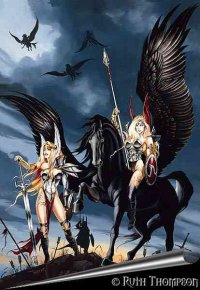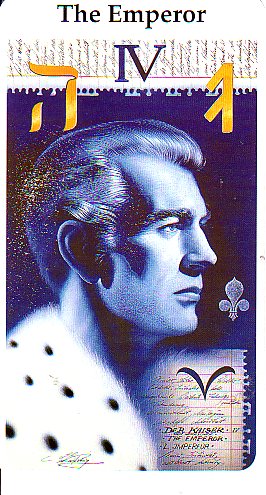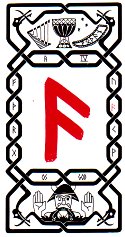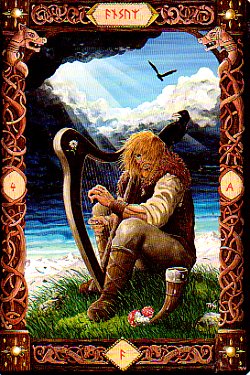


|
OdinDevotional Site |

|

|
ODIN, (also known as Woden or Wotan), was the chief god of Germanic mythology.
As the oldest of the gods, he was treated by the other gods as their father
and considered to be the most learned god.
Odin's areas of control were: wisdom, magic, and warfare. Odin was often portrayed as the grey-bearded old man with one eye, his face hidden by a hood or a broad brimmed hat, because he had cast an eye into Mimir's well in return for a drink of its "immense wisdom". Even after losing an eye, Odin's love of wisdom was so profound that he was prepared to sacrafice himself to plumb its depths. He gained insight by hanging himself for nine days from Yggdrasil, the cosmic tree (imagery: think of the movie Conan when he was tied to the Tree of Woe). This voluntary death, and his subsequent resurrection by means of magic gave Odin greater wisdom than anyone else. It is possible that the obvious parallel between this myth and the Crucifixion gave Christianity a head-start in northern Europe. |
|
Tyr retained his interest in war but Odin
was looked upon as the inspiration for hard-bitten warriors because
he alone had the power to inspire men in battle to a state of berserk rage
in which they feared nothing and felt no pain.
Also, with the promise of an afterlife where Warriors could live to fight another day on behalf of Odin and the world against the forces of darkness, Odin began to be worshipped as a battle god. He was particularly favored by the Vikings and rose to prominence in the 8th and 9th centuries. These seafarers and raiders were attracted by Odin's love of battle as the 'father of the slain'. |

|
In return for this assistance over their enemies, Odin commanded the Valkyries, who dispatched his will on the battlefield without question (except 1 time and she ended up in a heap of trouble). |

|
Valkyries were originally thought of as dark angels of death, who
soared over the battlefields like birds of prey, meting out fate in the
name of Odin. Chosen heroes were gathered up and borne away to Valhalla,
the heavenly abode of Odin and the other gods. Valkyries are Odin's
daughters through Freya, and form an all female military squadron known
by any of the following: Odin's Battle Maidens, Shield Maidens or Chosers
of the Slain.
Valhalla is the divine fortress of Asgard. It is an immense hall where the warriors would eat, drink and practice the military arts daily. If wounded during practice, the Valkyries would heal them so that they would be ready the next day to practice some more. |
|
Odin's own
worship appears to have gone into decline in the early 11th century,
at the close of the Viking age. Violent times were on the wane as Viking
colonists settled down as peaceful farmers and traders.
Something to ponder: The fact that times were changing
and the use of violence as a means of measuring right and wrong (see: Tyr)
was not acceptable anymore. This corresponds to the reason that Ragnarok started:
Ragnarok, known as the series of events that spelled the doom of the gods,
began with the death of Odin's son Balder and
the realization by the gods that in Loki, the god of fire, they had
tolerated the growth of evil. It would seem peaceful times and everyone's
belly full (both man and gods)
means that evil can breed with the knowledge that no
one wants to rock the boat.
Even with a mighty army of heroic warriors, Odin - through his knowledge of the future - knew the outcome of Ragnarok: The battle would be fierce, and the gods would end up dying, but they would take the forces of evil with them, thus saving humanity. Odin's only consolation was the foreknowledge that his resurrected son Balder would be worshipped in his stead in a new age and new land which would rise from the sea. |
Rune Meanings and Magical Usage |
|

|
This rune corresponds to a phonetic 'A'. I have read different
accounts as to what it stands for. Examples are: Ansuz, Ansur, Asa, Os.
From Runic States by Kevin Steffen - Keywords: Messenger, Inspiration, Spirit Power and Knowledge, Song and Poetry, Communication, Nepture, the number 4. Esoteric Meanings: This rune ANSUR is both the answer of your prayers, and a gift of knowledge from Odin, yet it could be a trick of Loki. The Germanic trives were wary of all gifts from the Gods, because there was often a price to pay with them. The Gods normally did not get involved in the affairs of men, unless they could frustrate the schemes of the giants by doing so. With Odin's precognitive skills, the Gods helped men in order to help themselves at Ragnarok. To this end the Valkyrie searched the battlefields for the bravest and best fighters, to carry them to Valhalla to await Ragnarok. Another practice of Odin's was to set tests for heroes and other candidates for Valhalla. When you deal with Odin or shamanism, there is a great potential for power, and a certainty that you will be placed in situations which will force you to grow up, develop yourself, and to move forward. After all, the entire motivation for Odin is to protect Asgaard and to prepare for Ragnarok. If you are going to gain the attention of Odin, you must be prepared to be thrown into situations which will train, challenge and test you. When you work with shamanism and the runes together you will definitely draw the attention of Odin. He is interested in heroes, not wimps. If you can not develop the moral character, skills and courage he requires, there is little concern as to whether you pass or fail the test. The test will always be scrupulously fair, but very difficult, and failures can always be dangerous. Valhalla is not for the faint of heart. Today this rune, ANSUR, is communication in all of its myriad of...forms. When reversed, beware Loki's lies, yet when upright, it may hold the answer to your prayers as a gift from Odin. Astrologically, ANSUR, relates to the planet Neptune, the planet of the arts and spiritual matters. ANSUR is grouped with Raidho and Tiwar in matters of the spirit. Raidho portrays spiritual development (journey), Tiwar (Tyr) is the discipline of the spirit, while ANSUR is the knowledge and powers of the spirit matters. |
|
Northern Mysteries and Magick by Freya Aswynn
This is the 4th fune of the futhark. Ansuz represents order, the defenders of which in our mythology, are the Aesir. The Ansuz rune represents consciousness, intelligence, communication and reason. The element of Odin, the godforce behind this rune, is air. Air is a penetrating medium necessary to all life-forms. It is through air that sound becomes audible. In an airless environment, sound cannot be heard, and sound is the other main esoteric feature of the Ansuz rune, including the origins of sound as a medium of communication between people, and the sounds of Nature. The magical use of sound to expand one's consciousness and the chanting of runes in a manner in which sound is closely linked with breath can give amazing results. Speech is one of Odin's attributes, as are poetry and the aforementioned magical uses of sound. It is no coincidence that Odin, the god of words and communication, is credited with giving humankind knowledge of the ruens. The philosophy contained in the Northern tradition maintains that we are descendants of the gods; and in this respect, the Ansuz rune relates to the ancestors. On a higher level, Ansuz represents the life energy that is called 'prana' in the East, and appropriately 'od' or 'odic' energy by various German magicians. On a practical working level, Ansuz is the counterbalance to Thurisaz. As Thurisaz is used to fetter, Ansuz can be used to unfetter. This rule is also true for psychological fetters, such as anxieties or phobies in the individuals unconscious mind, which act as hindrance preventing further personal growth or spiritual progress. |

|

|
Futhark - A Handbook of Rune Magic by Edred Thorsson
Ansuz is the mysterium tremendum of the rune row. The A-rune is instrumental in the creation of mankind. It describes two of the several spiritual gifts given to Askr and Embla (the primal man and woman) by the gods Odhinn, Hoenir, and Lodhurr (a threefold aspect of the god Odhinn). These gifts were ond or anda (breath, spirit, animating life principle) and odhr (inspired mental activity, inspiration). This is the stave of Odhin as the numinous god of magic and of ecstasy. Ansuz is the receiver-container/transformer-expresser of spiritual power and numinous knowledge. This force is received from the AEsir and transformed in humanity to be re-expressed toward the multiverse in magical and religious acts. This ecology of power works in tandem with that described by Odhinn's reception of rune wisdom and subsequent expression of that wisdom to mankind. The A-rune ecompasses the medium throug hwhich numinous knowledge is received, the container of that power, and the force itself, which is manifested as the ecstatic state. This is the rune of the word, song, poetry, and magical incantation as a container and expresser of magical force. Ansuz is a magical ancestral power, one that has been handed down from generation to generation along genetic lines. The ancient Germanic peoples knew that they were 'descended from their Gods,' as the geneologies of their kings, heroes, and clanic chieftans show. The power link between gods and men was, for them, unbroken. It remains so. Through the power of this rune the realization of the link between the ancestral gods and their people may be regained. The A-rune embodies the death mysteries of the AEsir. Key words: Reception - transformation - expression, numinous knowledge, inspiration, ecstasy, word-song, death mysteries. Magical workings: Increase of both active and passive magical powers and clairvoyant abilities, etc. Convincing and magnetic speech, and the power of suggestion and hypnosis. Acquisition of creative wisdom, inspiration, ecstasy, and divine communication. Banishing the death and terror through knowledge of Odhinn. |